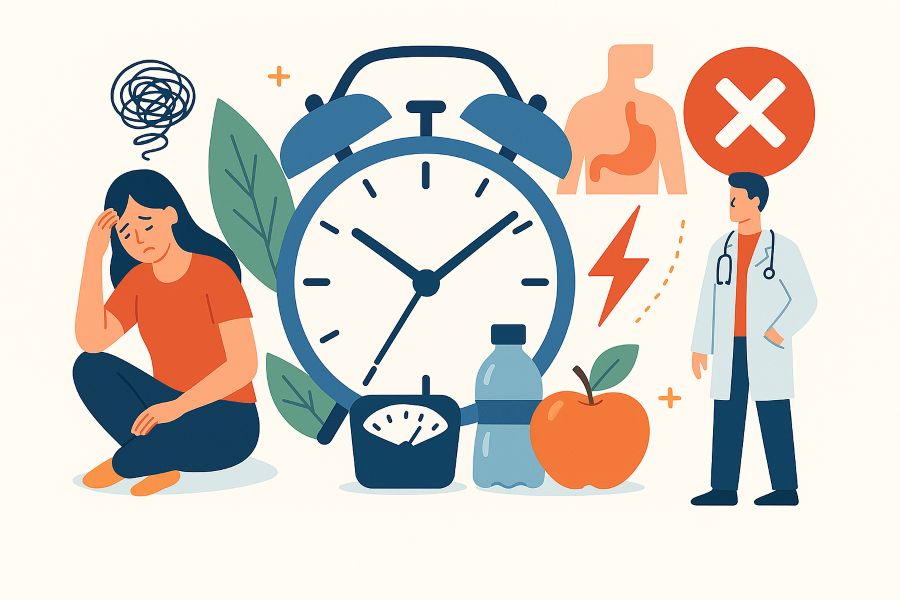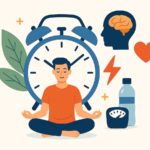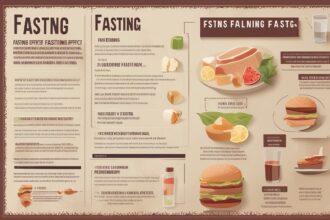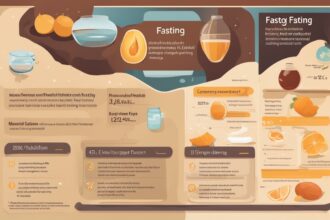Hey there, fellow health enthusiasts! If you’ve been exploring the world of health fasting, you’ve likely heard about its potential benefits—think weight loss, improved mental clarity, and even better metabolic health. But let’s get real for a moment: fasting isn’t all sunshine and rainbows. Like any lifestyle change, it comes with its own set of challenges and side effects that can catch you off guard if you’re not prepared. Whether you’re a newbie to intermittent fasting or a seasoned pro with extended fasts under your belt, understanding these side effects is key to making fasting work for you safely and sustainably. In this deep dive, we’ll unpack the most common fasting side effects, back them up with science, and share practical tips to help you navigate this journey with confidence. Let’s jump in!
The Basics of Health Fasting and Why Side Effects Happen
Before we dive into the nitty-gritty of fasting side effects, let’s quickly recap what health fasting is all about. Fasting involves voluntarily abstaining from food and, in some cases, drink for a specific period. Popular methods include intermittent fasting (like the 16:8 method, where you fast for 16 hours and eat during an 8-hour window) and prolonged fasting (going without food for 24 hours or more). The goal often revolves around health benefits such as improved insulin sensitivity or cellular repair through autophagy (Santos et al., 2016). But here’s the thing—when you restrict food intake, your body has to adapt, and that adjustment period can stir up some temporary discomfort. Think of it as your system hitting the reset button; it’s not always a smooth transition. Side effects often stem from shifts in blood sugar, hydration levels, or even psychological responses to hunger. Let’s break down the most common ones.
Hunger Pangs and Irritability: The Early Struggles of Fasting
Let’s start with the most obvious side effect of health fasting: hunger. When you skip meals or drastically cut your eating window, your stomach might growl louder than a bear in hibernation. This isn’t just your imagination—hunger hormones like ghrelin spike when your body expects food, signaling your brain that it’s time to eat (Cummings et al., 2001). Alongside hunger often comes irritability, affectionately dubbed “hanger” by many fasters. This moodiness can be tied to drops in blood sugar levels, which affect serotonin production and leave you feeling cranky. For beginners, this can be especially tough during the first few days of a fasting routine. The good news? Your body often adjusts after a week or two as it gets used to the new schedule.
So, how do you cope? Here are a few tried-and-true tips to ease the hunger and keep your cool:
- Stay hydrated—sometimes thirst masquerades as hunger, so sip water throughout the day.
- Distract yourself with light activity, like a short walk or a hobby, to take your mind off food.
- Ease into fasting by starting with shorter fasts (like 12:12) before jumping to longer ones.
- Break your fast with nutrient-dense foods to stabilize blood sugar and curb cravings.
Fatigue and Low Energy: Why Fasting Might Zap Your Vibe
Ever felt like you’re dragging yourself through the day while fasting? You’re not alone. Fatigue is a common side effect, especially during the initial stages of fasting for health. When you’re not eating, your body switches from using glucose as its primary fuel to burning stored fats for energy through a process called ketosis. This transition can take a few days—or even weeks—and during that time, you might feel sluggish as your energy systems recalibrate (Veech, 2004). Additionally, if you’re not getting enough electrolytes or calories during eating windows, your energy levels can tank further. Dehydration, often overlooked during fasting, can also play a role in making you feel wiped out.
The fix? It’s all about balance and preparation. Check out these strategies to keep your energy up while embracing a healthy fasting lifestyle:
- Add a pinch of salt to your water or sip on an electrolyte drink (without sugar) to replenish sodium and potassium.
- Ensure your meals are rich in healthy fats and proteins to provide sustained energy when you do eat.
- Avoid overexertion—scale back intense workouts during the first few days of fasting.
- Get enough sleep; rest helps your body adapt to the stress of fasting more efficiently.
- Listen to your body—if fatigue persists, consider consulting a healthcare provider to rule out nutrient deficiencies.
Headaches and Dizziness: A Common Fasting Hurdle
Headaches and dizziness often pop up as unwelcome guests during health fasting, especially if you’re new to it or doing a longer fast. These symptoms can be linked to several factors: dehydration, low blood sugar, or even caffeine withdrawal if you’re used to your daily coffee fix and cut it out during fasting hours (Johns Hopkins Medicine, 2020). When your body’s glucose levels dip, your brain might not get the quick energy it’s used to, leading to that throbbing sensation or lightheadedness. Stress from hunger can also tighten muscles in your neck and shoulders, contributing to tension headaches.
Thankfully, these issues are often temporary and manageable. Drinking plenty of water is a game-changer—aim for at least 8–10 glasses during your fasting window. If caffeine withdrawal is the culprit, try tapering off slowly before starting your fast rather than going cold turkey. And if dizziness hits, sit down, breathe deeply, and sip some water to stabilize yourself. Persistent symptoms, though, are a red flag—don’t ignore them, and reach out to a doctor if they don’t ease up after a few days.
Digestive Upsets: How Fasting Impacts Your Gut
Switching to a healthy fasting routine can throw your digestive system for a loop. Some folks experience bloating, constipation, or even diarrhea as their gut adjusts to new eating patterns. When you fast, your digestive tract slows down since there’s less food to process, which can lead to constipation if you’re not hydrating enough or getting fiber during eating windows (Harvard Medical School, 2019). On the flip side, breaking a fast with heavy or processed foods can overwhelm your system, causing bloating or loose stools. There’s also the psychological angle—stress about fasting or overeating post-fast can mess with your gut-brain connection.
To keep things running smoothly, focus on hydration and mindful eating. Break your fast with light, easy-to-digest foods like soups or steamed veggies before diving into heavier meals. Probiotics, whether from yogurt or supplements, might also help balance your gut flora during this transition. If digestive issues linger, it’s worth tweaking your fasting approach or chatting with a nutritionist to ensure you’re not missing key nutrients.
Long-Term Considerations and When to Stop Fasting
While many side effects of health fasting are short-lived, it’s important to keep an eye on how your body responds over the long haul. Extended or frequent fasting without proper nutrition can lead to risks like nutrient deficiencies, muscle loss, or even disordered eating patterns in some cases (Trepanowski & Bloomer, 2010). Women, in particular, might notice changes in menstrual cycles due to hormonal shifts triggered by calorie restriction (Martin et al., 2018). And let’s not forget mental health—fasting can sometimes heighten stress or anxiety if it feels too restrictive or becomes obsessive.
The takeaway? Fasting isn’t a one-size-fits-all solution. If you experience severe side effects—think extreme fatigue, fainting, or persistent mood swings—it’s time to hit pause and reassess. Work with a healthcare provider or dietitian to tailor a fasting health plan that suits your unique needs. Remember, the goal is to boost your well-being, not to push your body to its breaking point. Start slow, stay informed, and always prioritize safety over speed when chasing those fasting benefits.
As we wrap up this deep dive into the side effects of health fasting, I hope you’re feeling more equipped to tackle this journey with eyes wide open. Yes, fasting can be a powerful tool for improving your health, but it’s not without its bumps along the way. From hunger pangs and fatigue to headaches and digestive quirks, these challenges are often your body’s way of adapting to a new rhythm. By staying hydrated, eating mindfully during feeding windows, and listening to your body’s signals, you can minimize discomfort and maximize the perks of a healthy fasting lifestyle. Have you experienced any of these side effects yourself? Drop a comment below—I’d love to hear how you’ve navigated them! And remember, if fasting ever feels like too much, there’s no shame in taking a break or seeking professional guidance. Here’s to fasting smart and staying healthy!
References
- Cummings, D. E., Purnell, J. Q., Frayo, R. S., Schmidova, K., Wisse, B. E., & Weigle, D. S. (2001). A preprandial rise in plasma ghrelin levels suggests a role in meal initiation in humans. Diabetes, 50(8), 1714–1719.
- Harvard Medical School. (2019). The lowdown on intermittent fasting and digestive health. Harvard Health Publishing.
- Johns Hopkins Medicine. (2020). Intermittent fasting: What are the benefits and risks? Johns Hopkins Health Review.
- Martin, B., Pearson, M., Kebejian, L., Golden, E., & Mattson, M. P. (2018). Sex-dependent metabolic, neuroendocrine, and cognitive responses to dietary energy restriction and excess. Endocrinology, 149(9), 4318–4333.
- Santos, H. O., Macedo, R. C., & Genario, R. (2016). The effects of intermittent fasting on metabolic health: A systematic review. Nutrition Reviews, 74(12), 753–761.
- Trepanowski, J. F., & Bloomer, R. J. (2010). The impact of religious fasting on human health. Nutrition Journal, 9, 57.
- Veech, R. L. (2004). The therapeutic implications of ketone bodies: The effects of ketone bodies in pathological conditions. Prostaglandins, Leukotrienes and Essential Fatty Acids, 70(3), 309–319.






